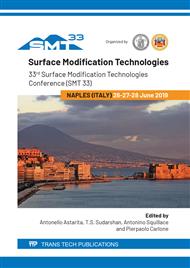[1]
K. Nieme, P. Vuoristo, T. Mantyla, Properties of alumina-based coatings deposited by plasma spray and detonation gun spray process, J. Therm. Spray Tech. 3 (1994) 199-203.
DOI: 10.1007/bf02648279
Google Scholar
[2]
V. Ulianitsky, A. Shtertser, I. Batraev, I. Smurov, Deposition of Dense Ceramic Coatings by Detonation Spraying, in: Proceed Intern. Thermal Spray Conference & Exposition (ITSC-2014), May 21-23, 2014, Barcelona, Spain, DVS-Berichte Volume 302, DVS Media GmbH, Düsseldorf, 2014, p.349 – 352.
DOI: 10.4028/www.scientific.net/msf.1016.1350
Google Scholar
[3]
L. Pawlowski, The relationship between structure and dielectric properties in plasma-sprayed alumina coatings, Surf. Coat. Technol. 35 (1988) 285–298.
DOI: 10.1016/0257-8972(88)90042-4
Google Scholar
[4]
M. Niittymäki, K. Lahti, T. Suhonen, J. Metsäjoki, Effect of temperature and humidity on dielectric properties of thermally sprayed alumina coatings, IEEE Trans. Dielectr. Electr. Insul. 25 (2018) 908–918.
DOI: 10.1109/tdei.2018.006892
Google Scholar
[5]
M. Niittymäki, I. Rytöluoto, K. Lahti, J. Metsäjoki, T. Suhonen, Role of microstructure in dielectric properties of thermally sprayed ceramic coatings, in: Proceed. 1-st Intern. Conf. on Dielectrics (ICD 2016), 2016, Montpellier, France, p.1102–1105.
DOI: 10.1109/icd.2016.7547811
Google Scholar
[6]
F.L. Toma, S. Scheitz, L.M. Berger, V. Sauchuk, M. Kusnezoff, S. Thiele, Comparative study of the electrical properties and characteristics of thermally sprayed alumina and spinel coatings, J. Therm. Spray Tech. 20 (2011) 195–204.
DOI: 10.1007/s11666-010-9580-2
Google Scholar
[7]
V.Yu. Ulianitsky, A.A. Shtertser, I.S. Batraev, Electrical insulation properties of aluminum oxide detonation coatings, Obrabotka metallov (tekhnologiya, oborudovanie, instrumenty) = Metal Working and Material Science. 20(4) (2018) 83–95 (In Russian).
DOI: 10.17212/1994-6309-2018-20.4-83-95
Google Scholar
[8]
V. Ulianitsky, A. Shtertser, S. Zlobin, I. Smurov, Computer-Controlled Detonation Spraying: From Process Fundamentals Toward Advanced Applications, J. Therm. Spray Tech. 20 (2011) 791-801.
DOI: 10.1007/s11666-011-9649-6
Google Scholar
[9]
Yu.A. Nikolaev, M.E. Topchiyan, Analysis of equilibrium flows in detonation waves in gases, Combust. Explos. Shock Waves. 13(3) (1977) 327-338.
DOI: 10.1007/bf00740309
Google Scholar
[10]
V. Ulianitsky, A. Shtertser, V. Sadykov, I. Smurov, Development of catalytic converters using detonation spraying, Mater. Manuf. Process. 31 (11) (2016) 1433–1438.
DOI: 10.1080/10426914.2016.1151041
Google Scholar
[11]
G. Ervin, E.F. Osborn, The system Al2O3 – H2O, J. Geol. 59 (4) (1951) 381-394.
Google Scholar
[12]
Information on https://www.accuratus.com/alumox.html.
Google Scholar
[13]
Information on https://www.labmanager.com/white-papers-and-application-notes/2010/05/ resistivity-conductivity-measurement-of-purified-water#.XI9ZW6BS-Uk.
Google Scholar


